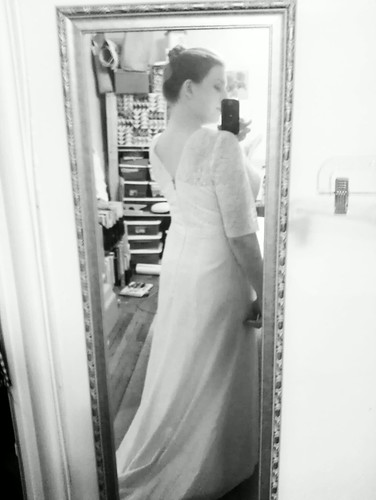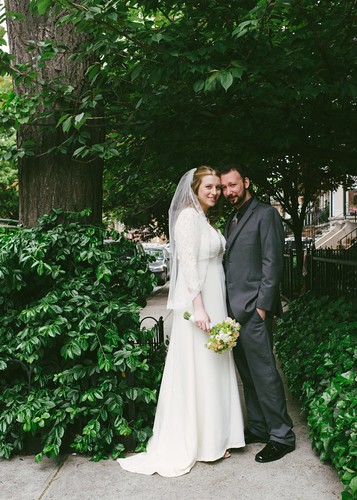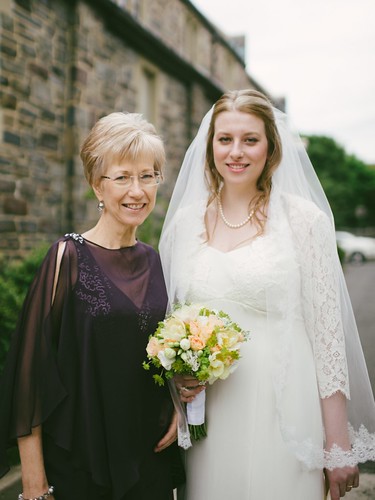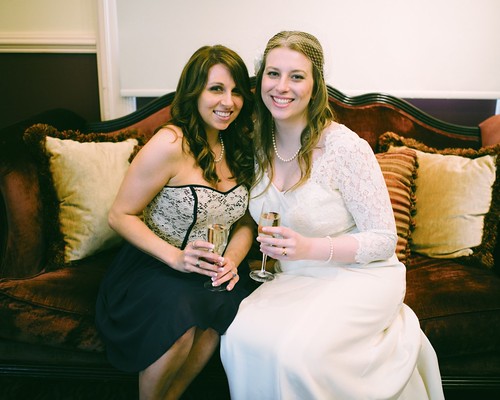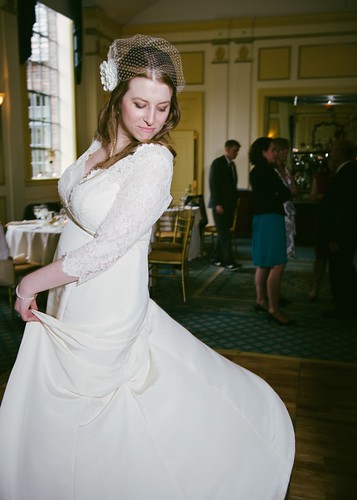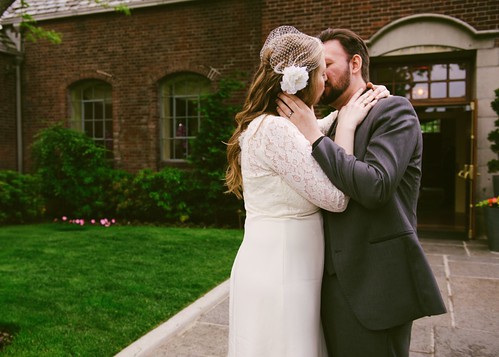It has take me a LLOOOooooong time to get around to writing about the details of making my wedding dress. This post is not quite as detailed as I'd like (ahem) and ends rather abruptly but I'm a sewist, not a writer and this post is past due so get a drink and settle in, this is a long one with lots of photos & links.
So... exactly how did I go about making my wedding dress?
Lots of research and planning followed by lots of work!
Planning
Major Design References and inspiration:
The elements that I wanted most were lace and sleeves. I was going for a traditional, vintage look so pouffy and strapless were out. Favorite designers were Claire Pettibone, Temperly London, Jim Helm, Carolina Herrera (Twilight, Bella’s wedding dress), Kate Middleton (the lace bodice w/ sleeves), Dolce and Gabanna, and of course a million pins on pinterest. Rather than repost a bunch of inspiration pics, just go check out my pinterest board if you are so inclined.
I started in December (6 months out) I made a bunch of muslins. Most of them were disappointing and would have required a lot of and Franken-fitting. Once I had settled on a pattern and made the muslin for it I was THRILLED with the look and fit. The minor corrections that I made for fit were: shift shoulder seam back ½”, raise armhole ½”, reduce each back seam 1”, and reduce each under-bodice side seam ½” at top; reduced the front neckline at the princess seams and increase front bodice princess seam length at empire seam (this adjusted the fit for my full bust). Then I made a second bodice muslin and replaced the first one. It fit fantastically (I wore it for over an hour because I was so excited). I had marked the shorter train length on the muslin and decided to go with it, but added 6” at the center back so that it would be a little longer. I had also made elbow length sleeves for the first muslin but decided to go with ¾” length sleeves for the final version.
 |
| Simplicity 1909, the clear winner of the muslin stage. |
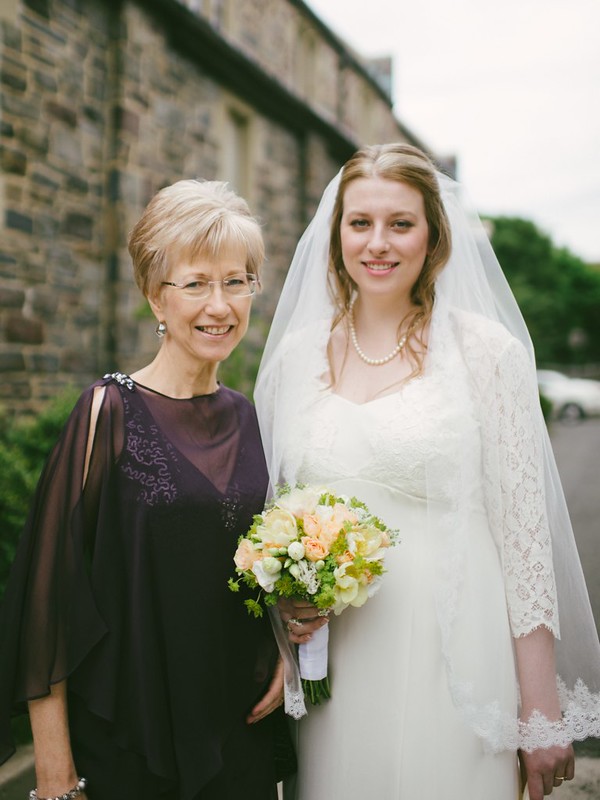 |
| The Result |
Materials
Fabric Shopping
Chic Fabrics – Silk Charmeuse lining, Cotton Batiste and Cotton Muslin.
 |
| My home away from home. |
 |
| This is the lace I chose. It was the single most expensive part of the dress. |
Lennox Fine Fabrics - Silk Rayon Illusion Tulle (for the veil). 108” wide, 1.5 yards. I cut it down to 75” wide, which I think it may have been a little too wide.
Top Trimming: Spiral Steal bones (which I didn’t use after all), clear comb, alligator clips, & french netting for the veil and fascinator.
 |
| Top Trimming - one of my new favorites |
Pacific Trimmings: Gutterman thread, gold Riri Zipper with ivory cotton tape, gold hook & eye, silk pins, ribbons, etc.
Daytona Trim for Lace (for the Veil), and ribbon for the bustle.
 |
| I am so very in love with this lace and I've got like 9 yards extra! |
MS Schmalberg for silk flowers, which I didn’t end up using, but wish I could have!
Pany Silk Flowers in the Flower District where I found the silk flower for my fascinator.
Manhattan Wardrobe Supply for a padded satin hanger and wedding dress garment bag.
 |
| My favorite sewing reference books |
Books
Susan Khalje’s Couture Wedding Dress (not pictured) – I bought the CD, but I really didn’t like reading this as a digital book. The focus is on the specific construction employed in the example dresses (one of which I got to see at the Mood lace seminar). It isn’t exhaustive and doesn’t explain many alternate methods. It’s a good book, but I needed other references for my specific dress.
Reader’s Digest Complete Guide to Sewing – My old college standard and in my opinion, any edition of this book should be on every sewist's bookshelf. I also have the
Complete Guide to to Needlework and I freaking LOVE it.
Vogue Sewing – this one is pretty good, but I usually look here to see if it differs from the Singer Sewing Book.
Couture Sewing Techniques by Claire Scheaffer, obviously.
Sewing Specialty Fabrics - Singer Sewing Reference Library - I collect this series; it's great!
Claire Shaeffer's Fabric Sewing Guide - this is a great reference for all construction options for specific types of fabric. I relied on it a lot.
Singer Sewing Book by Mary Brooks Picken – This is my favorite vintage sewing reference book. It also has a nifty logo that I think would make a great sewing themed tattoo.
 |
| Sewing Tattoo perhaps? |
Classes
Craftsy:
The Couture Dress (Susan Khalje) – excellent, I highly recommend it especially for the muslin making and the finishing touches.
Craftsy:
Vintage Inspired Veils for the Modern Bride (Doreen Vandermeer). Pretty useful for the materials and techniques, but I had to go it alone for the lace application on my veil. I searched ALL FREAKING OVER for a flower that was nice enough to use on the fascinator but low end enough that it could be taken apart and reconstructed. Details on that in a future post (but no promises).
Mood Sewing Seminar: Lace (Susan Khalje) – I am SOOOO glad I was able to ask Susan some specific questions about choosing a lace and construction methods. She went over the specific types of lace and their applications. Susan also talked me into buying her book on CD and I got to chat with some of my favorite bloggers
Daughterfish,
Oonaballoona and
Marina.
 |
| Susan Khalje at Mood |
So with a muslin that made me happy, and avalanche of materials and reference sources I got to work making
The Dress.
Construction Details
I cut out all my muslins, the silk crepe and the silk charmeuse on the large cutting tables at work. I used a bunch of cheap lightweight cotton muslin as a bottom layer to sandwich the silks between (muslin/silk/pattern) which helped prevent slipping and keep the fabric grain straight.
 |
| Serrated scissors, fabric weights and lots of space. |
 |
| Cutting the charmuese lining |
All
seams were lock-stitched, pressed open and the allowances were stitched and pinked. I tested out french seams and also zig zag and pinked and the option I went with was the least bulky. I pressed all the seams with a silk organza press cloth, a clapper presser, and no steam.
 |
| The seam treatment on the right wins |
I sewed and hemmed the skirt pieces before assembling them with the bodices.
I knew it was extremely unlikely that my skirt would be too long and I’d already made 2 muslins so I felt comfortable pre-hemming. This was also the way the pattern instructions were written so I think that a fitting is expected for this level of project. The
lining hem is a ¼” double bend-back. The
body hem is machine blind-stitched using lace hem tape to reduce bulk.
 |
| Machine Blind Hem - not very couture, I know. |
I originally wanted to do a hand rolled hem, but it would have taken too long (time management decision!) and my test looked rather thick. I am reasonably happy with the results, but it looked a little scary before I pressed it.
 |
| Pressed Blind Hem - with lace hem tape |
The crepe
under bodice is underlined with silk organza. I basted the underlining to the self with silk thread. I wish I had used two layers of organza, or purchased a heavy weight organza. Looking back I would have tested out different weights, but good silk organza is NOT cheap. I catch stitched the bodice seams open.
 |
| Silk Organza Bodice Underlining - glass head pins and serrated scissors |
I further stabilized the (crepe)
neckline edge with bias strips of silk organza that I steam pressed (learned this trick at the Mood lace seminar from Susan and
Marina).
I cut the
lace over bodice at home so that I could lay out the pattern pieces and ruminate on it for a while before committing to cutting.
 |
| The pattern layout diagram wasn't very descriptive. |
 |
| Aligning the scallop valley with the shoulder seam-line. |
I took 24 hours to place, fuss and decide on the placement of the pieces in a way that would make the best use of the scallop edges. Finally I worked up the nerve to cut my
precious,
expensive,
french alencon lace.
 |
| I left myself plenty of margins for overlapping motifs |
I then thread traced the pattern pieces with blue thread.
 |
| Working at night makes for crummy instagrams |
My basting stitches were uneven (the front face had longer stitches) and
I would advise against this because the seam line got sort of blurry while I was sewing it together. In hindsight, I would recommend about a ½” stitch length with even stitches on both sides of the lace.
 |
| Thread traced seam allowances and notches |
 |
| Front bust dart & planned cut line |
I used a
combination of seam methods for the lace over bodice. The side seams and sleeve seams were lock-stitched, pressed open and catch stitched flat.
 |
| side seam allowances pressed open and catch stitched |
The shoulder seams were lapped and hand appliquéd where the motifs allowed and lock-stitched, pressed open and catch-stitched were the motifs did not work. The armholes were lock-stitched and bound with pressed silk organza bias strips.
 |
| Armholes bound with bias silk organza |
The bust darts were lapped and appliquéd by hand with silk thread; that was by far my favorite part.
 |
| Dart test swatch with lime green catch stitches |
At this point I stalled for a few precious days (less than 3 weeks to go!!!) because I wasn’t sure if I would need
straps (as the pattern) or boning in the lining seams to help hold up the bodice. I decided to go with straps but this required some extra fitting to ensure the strap length was correct.
With time running out I made a list of all the last steps and got real busy crossing them off!
Before attaching the bodice lining to the skirt lining I inserted 1/8” wide satin ribbon at the side seams/empire seams for
hanger loops. I tested the length out on the padded hanger that I bought for the dress. I wanted the loops to both hang around the hook of the hanger.
The lace over bodice to the crepe under bodice at the
empire seam.
The
bodice lining is attached to the bodice at the neckline edge. I machine lock stitched and under stitched the seam allowances toward the lining.
Once the self and the linings were assembled together I tacked the
side seam allowances together (inside where no one can see) at the empire seam. This was to ensure that the hanger loops would be supporting the entire dress and not just the lining.
I hate installing zippers as a general rule, but sewing it by hand with the best materials was such a pleasure.
 |
| hand picked zipper application |
 |
| Silk thread, hand picked zipper |
My RiRi zipper has gold teeth and ivory cotton tape. I hand picked the
zipper using silk thread doubled.
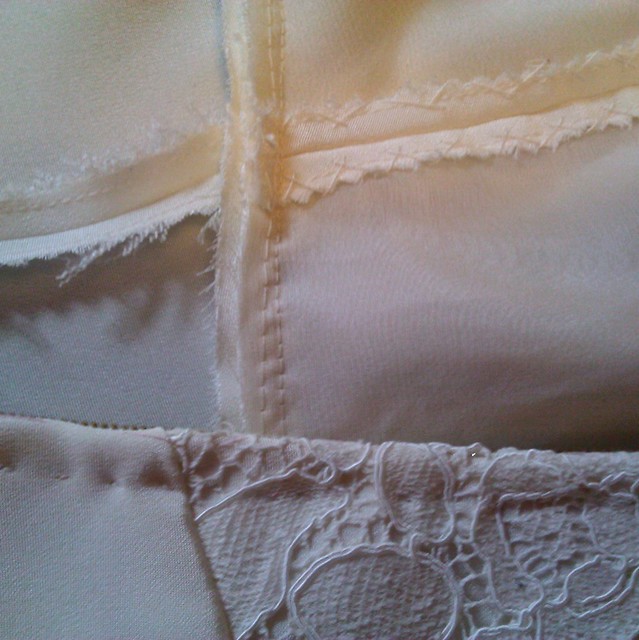 |
| Here you can see the bodice seam allowances catch stitched to the organza underlining. |
Then I fell stitched the charmuese lining to the zipper tape on the inside, and a gold hook and eye at the top finished the top edge.
 |
| Charmuese lining is so lovely. |
 |
| My Zipper is so pretty! |
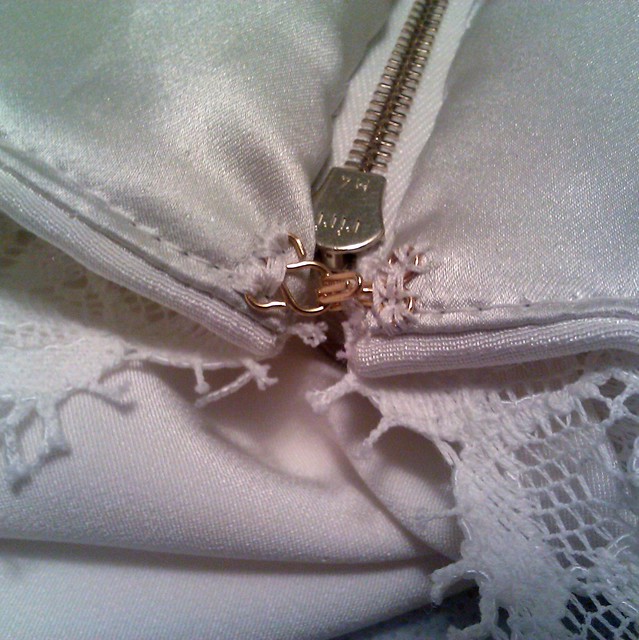 |
| Gold hook and eye - my stitching is not so great though. |
For
finishing touches; I tacked the under-bodice to the lace over bodice at the side seams near the top of the under-bodice; I made thread chain stitch carriers for the straps at the front empire seam and at the shoulder seam to ensure that the straps wouldn’t peak out from the lace. This also helped prevent the lace from slipping off my shoulders.
 |
| Thread loops at the shoulder seam to hold the straps |
One final fitting (thanks Sara!) to decide on
the bustle points and I then took 18 hours to decide between buttons or hooks; at the last minute I went with ribbons instead because I decided I didn’t want anything visible on the outside and I also saw a great tutorial on You Tube on how to use them.
 |
| Hook or button? How about neither?! |
The
fascinator and veil were the very last things that I did (day before the wedding). I worked on the fascinator on the afternoon before the rehearsal and I made the entire veil, from start to finish between 10 and 12 pm after the rehearsal dinner. I may blog about them eventually, but I posted about those projects on
my craftsy page so you can check it out there for now.
And that is the end of this post for now. I may edit to add more photos or additional details later.
Let me know if you have questions!















































